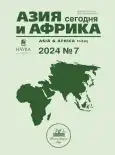In the last 2–3 decades due to a series of pragmatic reforms and export-oriented industrialization, carried out by a number of Asian developing countries (DCs), these countries have managed to significantly displace advanced economies (AEs) in the markets of finished industrial goods, and, on the whole, noticeably surpass the latter in terms of growth rates not only of labor productivity, but also total factor productivity. However, the AEs still outstrip many times not only less successful, but also successful DCs in terms of productivity level, which, according to the model calculated by the author, is determined by the much higher quality of their institutions and management, educational levels of the population and technologies used than in developing countries. In order to maintain their leadership in productivity dynamics, DCs, which are experiencing powerful deterring pressure from Western countries, must, while continuing the struggle to establish a more equitable multipolar world order, intensify the implementation of inclusive reforms that contribute to improving the quality of their institutions, accelerated growth of human capital, and the formation of an effective, technologically more complex and organizationally more advanced economy, based both on the internal market and active inclusion in world economic relations.
 5-16
5-16


 17-23
17-23


 24-31
24-31


 32-40
32-40


 41-48
41-48


 49-56
49-56


 57-65
57-65


 66-72
66-72


 73-80
73-80












